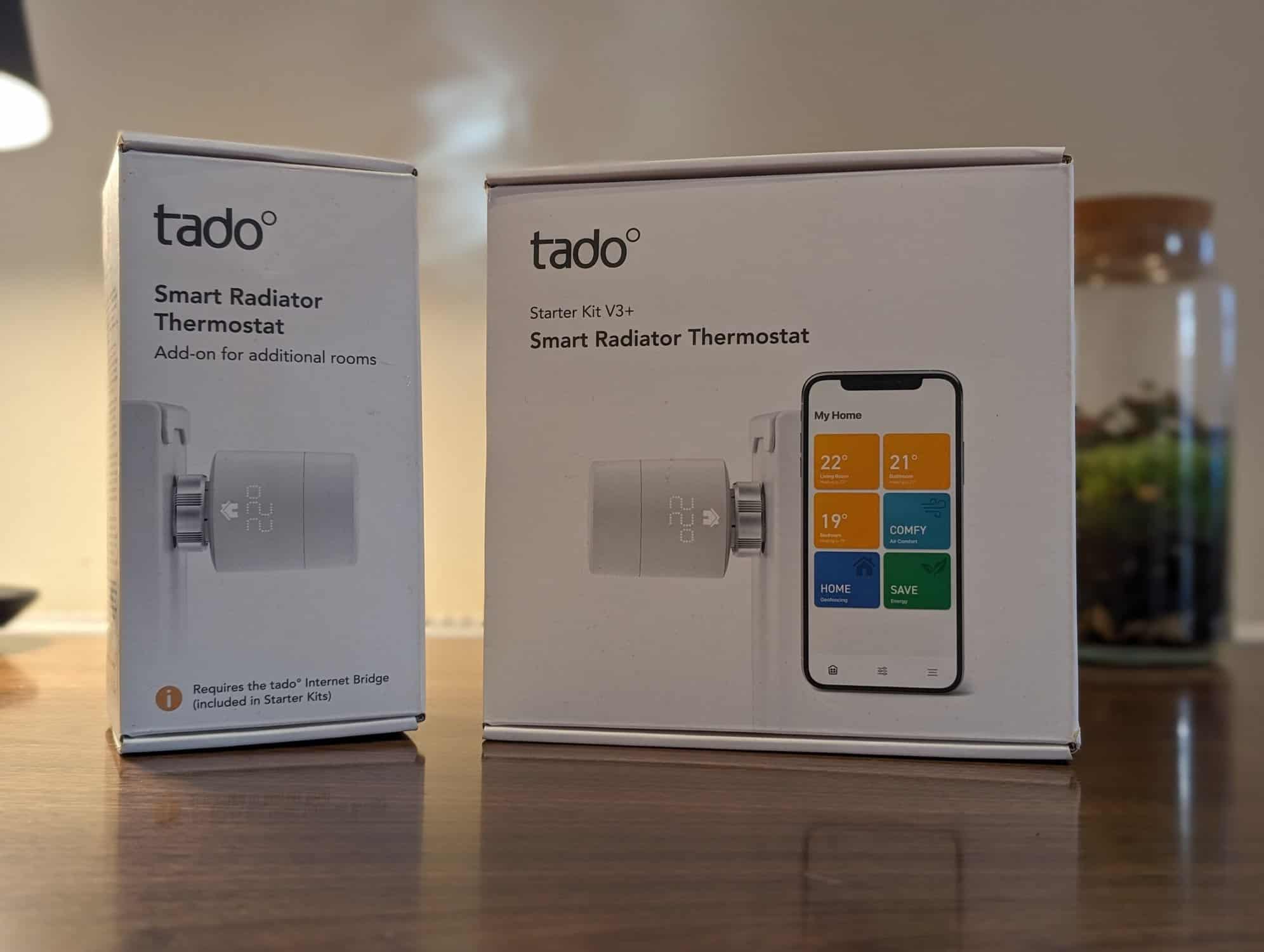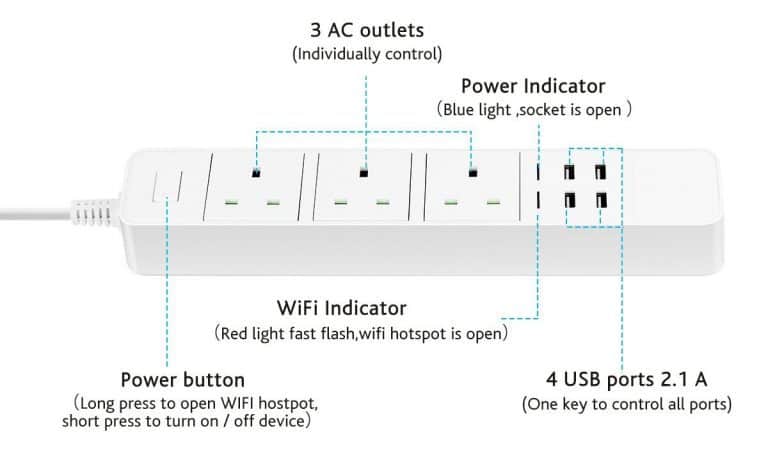Any links to online stores should be assumed to be affiliates. The company or PR agency provides all or most review samples. They have no control over my content, and I provide my honest opinion.
Tado is a smart home heating company that offers intelligent thermostats and radiator valves to provide control over heating in each room of your home.
I regularly recommend Tado because they seem to offer the best balance of performance, features and price.
While I did use Tado in its early days, I switched to Genius Hub (formerly Heat Genius) back in 2016. I think at the time, they were the only company doing smart radiator valves, allowing you per-room control of heating.
Since then, many brands have launched similar products, including Tado, Hive, Aqara, Drayton, Honeywell and more.
I have been contemplating moving away from Genius Hub for the past few years. I think it is a superb system, but they have pivoted more towards large installations. Some of my valves could do with replacement as I have damaged a few during decorating, but the valves cost £90, and the system doesn’t integrate as easily with Home Assistant or things like Homey.
Recently, I reviewed the excellent Aqara Smart Radiator Thermostat E1 Valve. I like this as I use Aqara extensively in my home, and it integrates with Home Assistant. However, they don’t have a whole home heating solution with boiler control.
Following my own recommendations, Tado seems to be the best bet, and the Tado Smart Radiator Thermostat Starter Kit V3+ is the first step in replacing my entire system.
Tado Smart Radiator Thermostat – Starter Kit V3+
Just to be clear, I have only tested the valves. I haven’t yet had a chance to use the thermostat with boiler control.
I, therefore, used the Smart Radiator Thermostat Starter Kit V3+, as this allowed me to use the smart radiator valves separately from my existing system. However, if you already have Tado in your home, you can just buy the radiator valves, as you will already have the required Internet bridge.
Tado Smart Radiator Thermostat V3 vs Tado Smart Radiator Thermostat V3 Basic
Tado has two models, the one I have reviewed and a basic model.
The basic model lacks a digital display, instead using analogue printed on the valve, and the on-device temperature adjustment is 19-25°c, but you get a normal temperature range through the apps.
It then lacks the Air Comfort Skill.
I like the fact they have two models as it allows you to install the cheaper model in less important rooms. At the time of writing, the basic model was at full RRP at £60 but has been as low as £40, and the normal model has an RRP of £75 but was available at £50.
Overview of the Tado Heating System
The Tado heating system consists of:
- Smart Thermostat – This wall-mounted, WiFi-connected thermostat replaces your existing thermostat and controls your boiler and overall home temperature [Not used for this review].
- Internet Bridge – Connects to your router and communicates between the thermostat, radiator valves, and Tado servers.
- Smart Radiator Thermostats – Battery-powered, wireless thermostatic radiator valves that mount onto existing radiators and allow control over each room’s temperature.
The starter kit includes the Smart Thermostat, Internet Bridge, and one Smart Radiator Thermostat for £119.99. Additional Smart Radiator Thermostats cost £59.99 each.
Features
The key features of the Tado heating system include:
Room-by-Room Control
The Smart Radiator Thermostats allow you to set schedules and target temperatures for each room. For example, I have the bedroom scheduled to heat up in the morning and evening, while the living room maintains a constant comfortable temperature during the day.
Geofencing
Using your phone’s location, Tado will detect when you leave home and automatically switch to an Away mode that turns down heating to save energy. It then ramps heating back up when you return home.
Weather Adaptation
The system uses local weather forecasts to adjust heating accordingly. If warmer weather is predicted, it will heat less.
Open Window Detection
Using the temperature and humidity sensors in the radiator valves, Tado can detect if a window is open and avoid wasting energy trying to heat the room.
Scheduling & Modes
You can set schedules for when you are home, away, or sleeping. Special modes like Holiday mode minimise heating when away for longer periods.
App Control & Automation
The Tado app provides control and monitoring from anywhere. You can also connect Tado to Alexa, Google Assistant, and Apple HomeKit for voice control and automation.
Installation
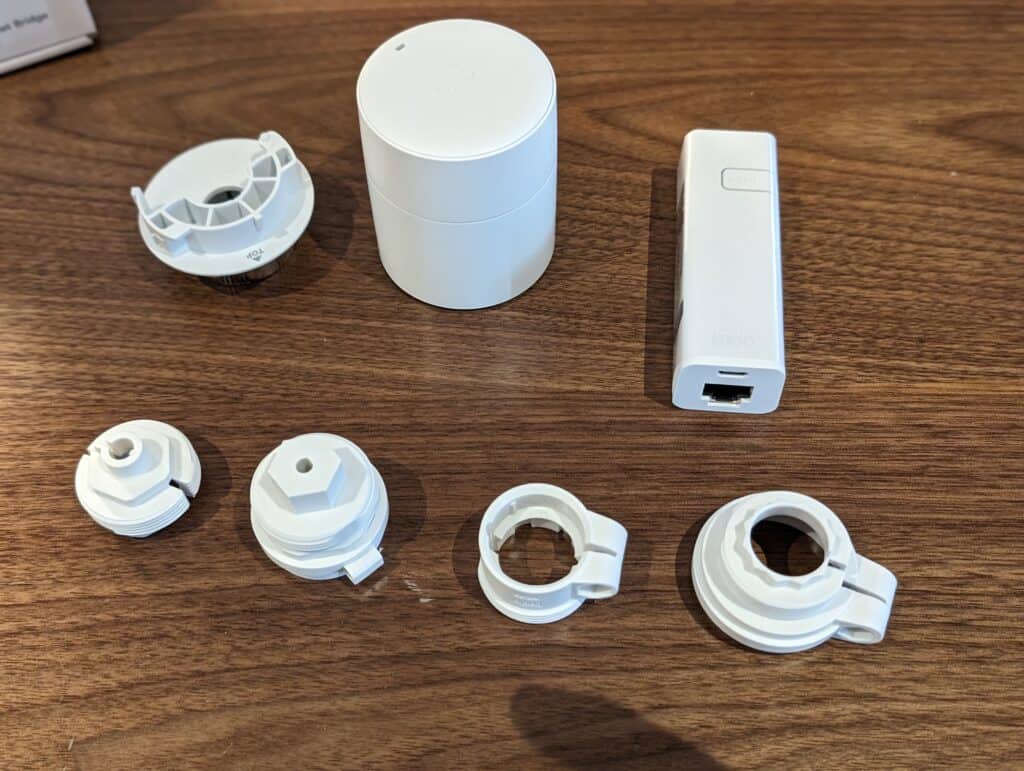
Installation is straightforward, even for those who might not consider themselves tech-savvy. The package includes all the necessary fittings, and the manual provides a step-by-step guide. Additionally, there’s an online installation assistant in case you run into any hurdles.
The package includes a lot of adaptors, allowing this to work with any radiator, but I found that the valve could be mounted directly onto the valve. I just screwed the bottom section on, removed the tab from the main unit and mounted onto the radiator.
The bridge connects to your router, enabling communication between the thermostat and your smartphone.
Set-Up
Set up was quite simple, I just added the valve and followed the basic set up process, which included putting the valve into pairing mode and waiting for it to connect.
At first, it did indicate there was a calibration issue, but this seemed to go away immediately. My Aqara valves have all had issues calibrating properly.
One handy feature within the app is the ability to blink the valve LED. This can be useful if you have a lot of valves in the home and move anything around. In general, I found the device management much more user-friendly than the Genius Hub system I am using.
Third-Party Connectivity – Home Assistant / Homey Integration
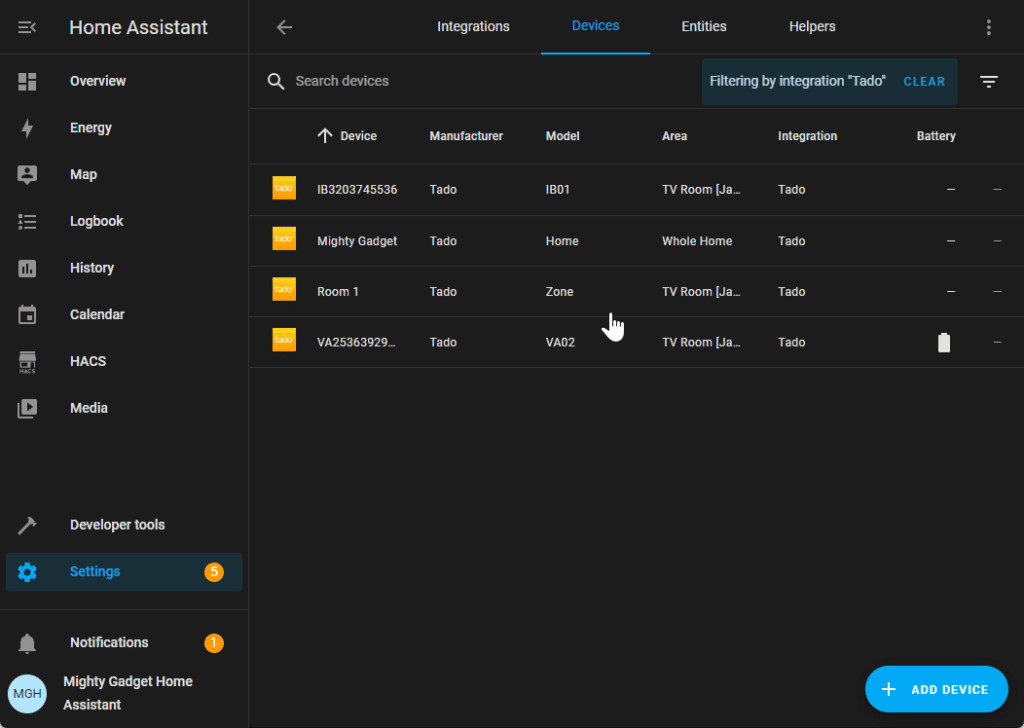
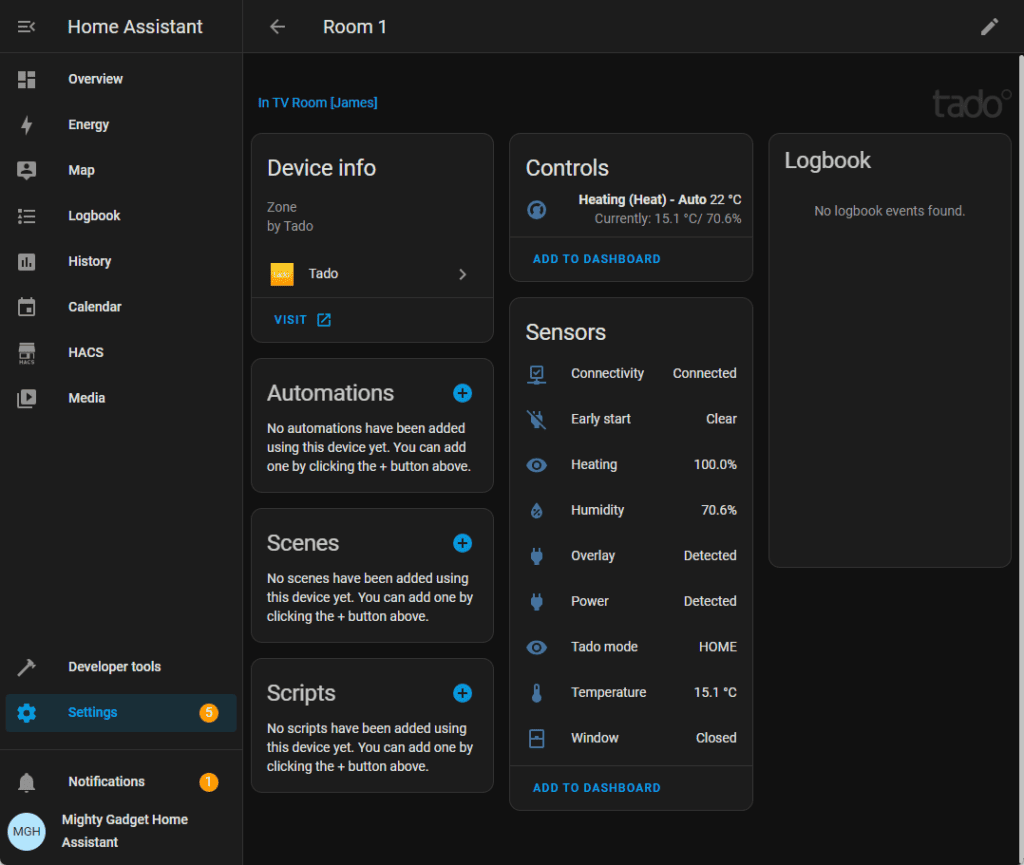
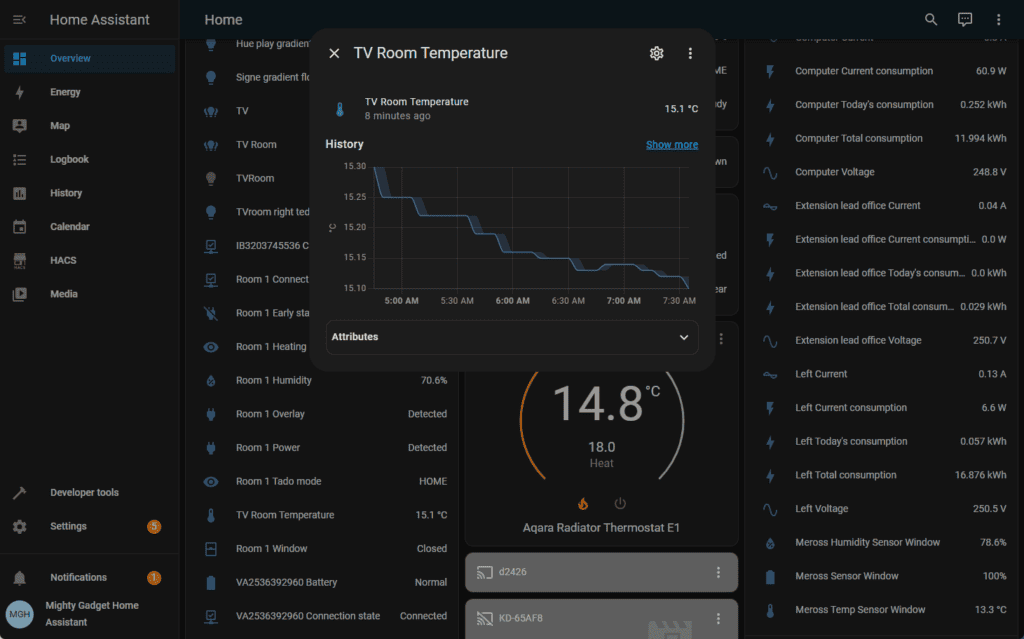
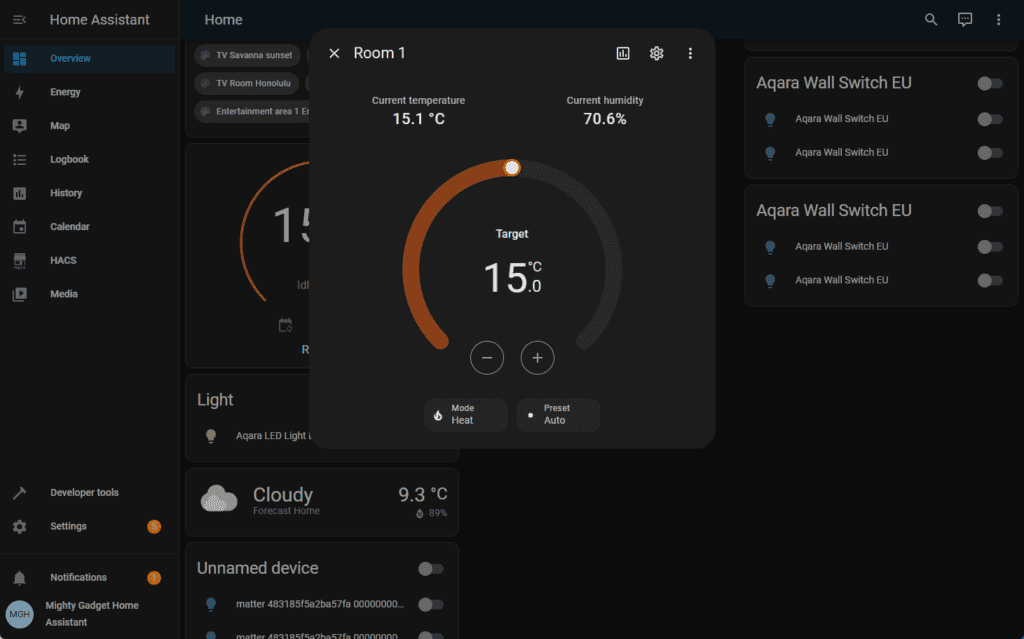
Tado’s Smart Radiator Thermostat is compatible with several third-party services, including Siri/Apple HomeKit, Amazon Alexa, Google Assistant, and IFTTT (If This, Then That). This integration allows users to control their heating using voice commands or create custom automation sequences using IFTTT.
For Home Assistant, Tado will be automatically recognised, and you can integrate either using your Tado credentials, or you can use HomeKit.
I chose the Tado credentials option as it integrates all the devices at once.
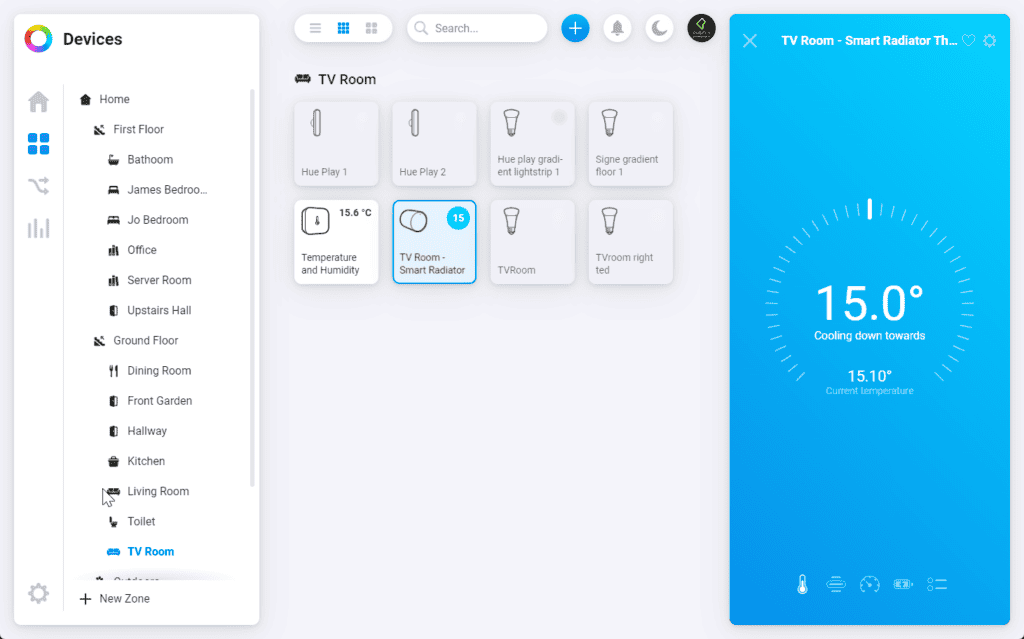
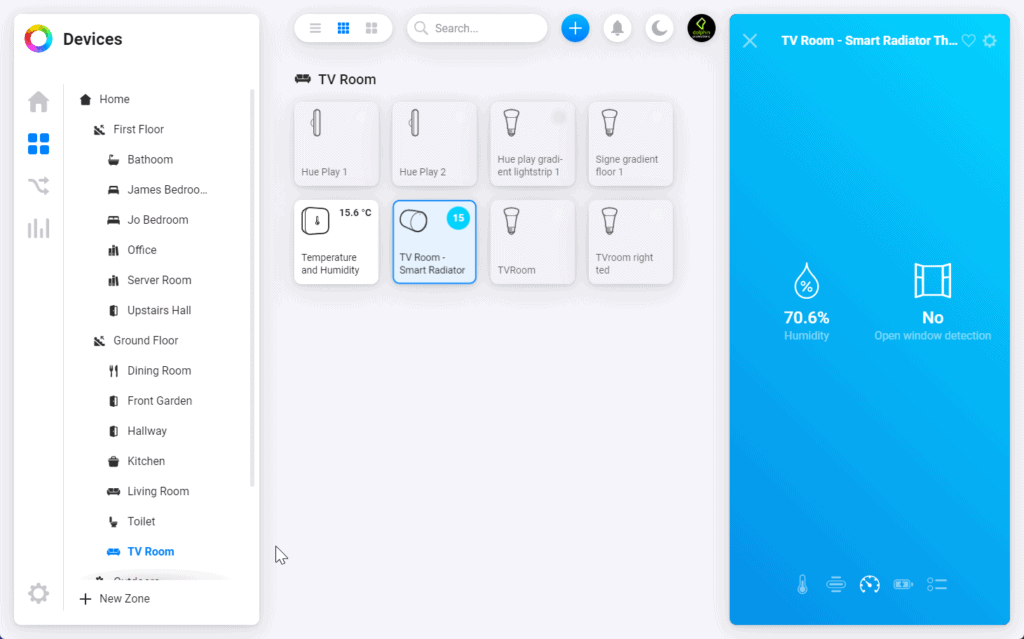
Tado also works directly with Homey, but not Samsung SmartThings.
One benefit for me with the third-party control is that it should allow me to mix up brands for my smart heating while still allowing the system to work as one using schedules.
App & Web UI
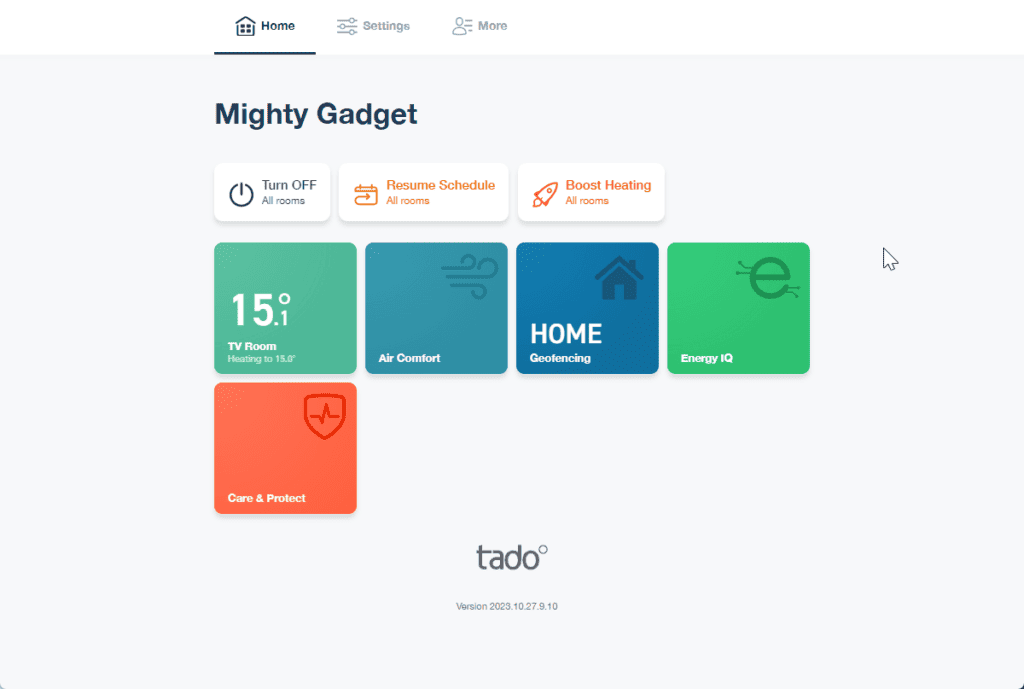
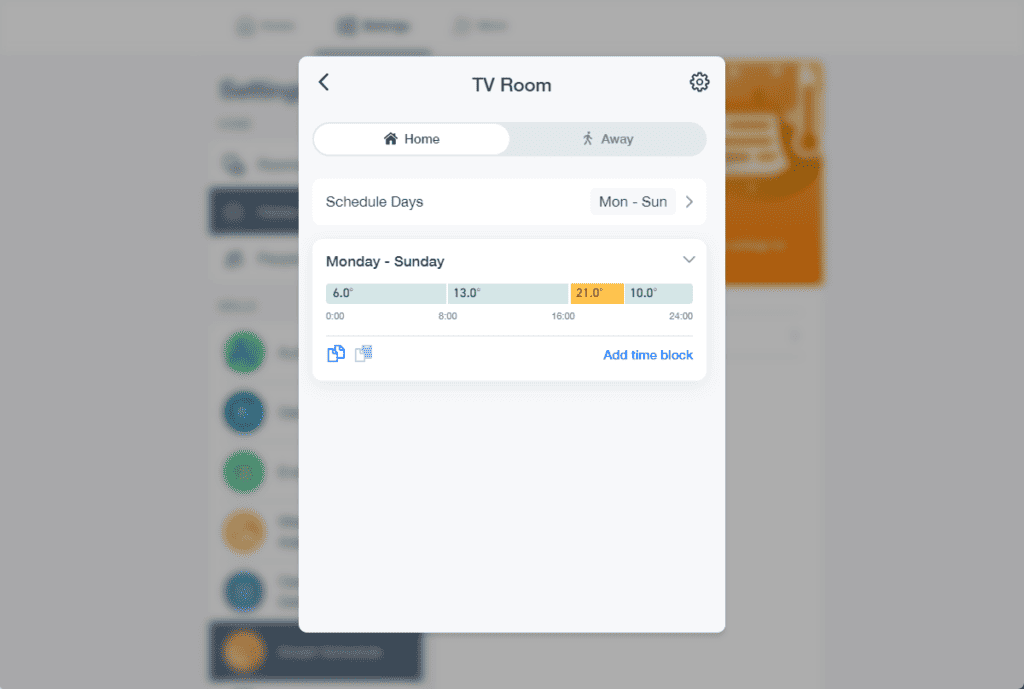
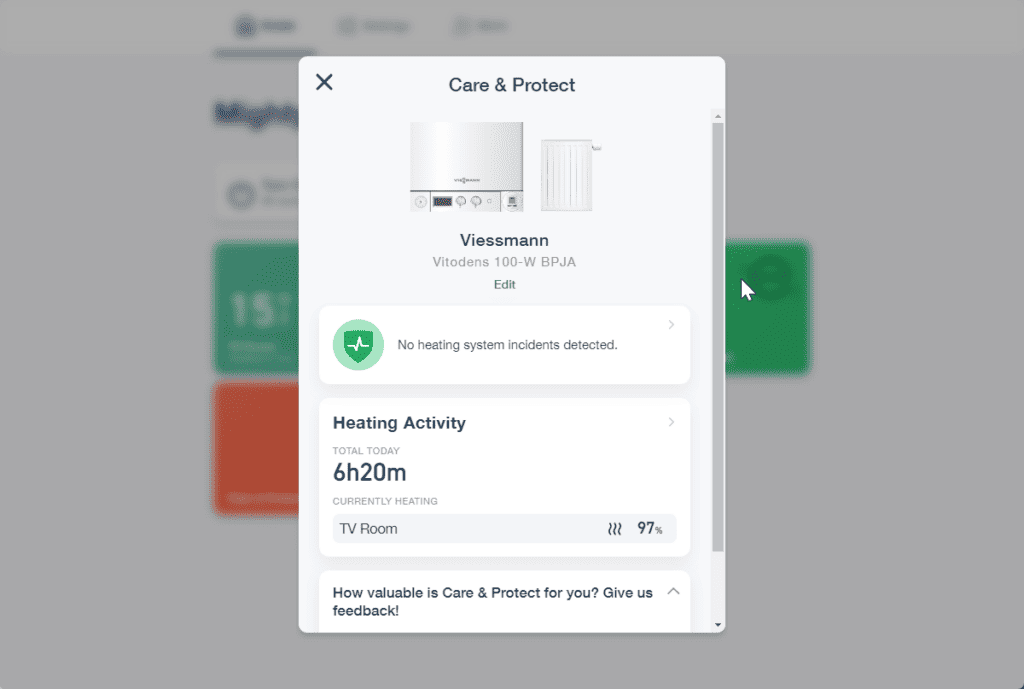
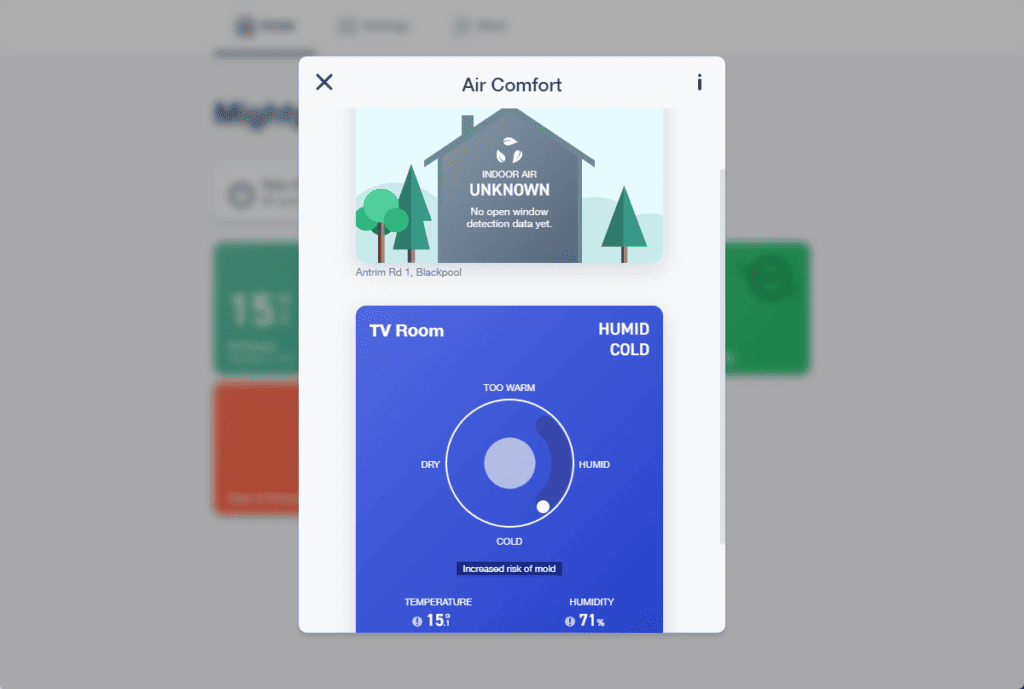
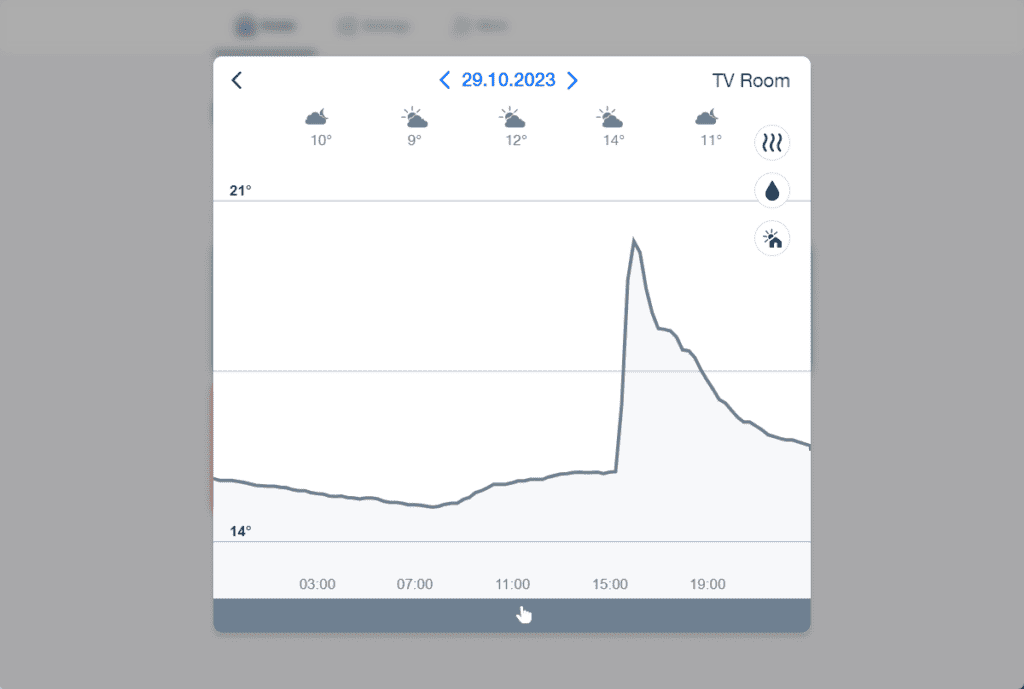
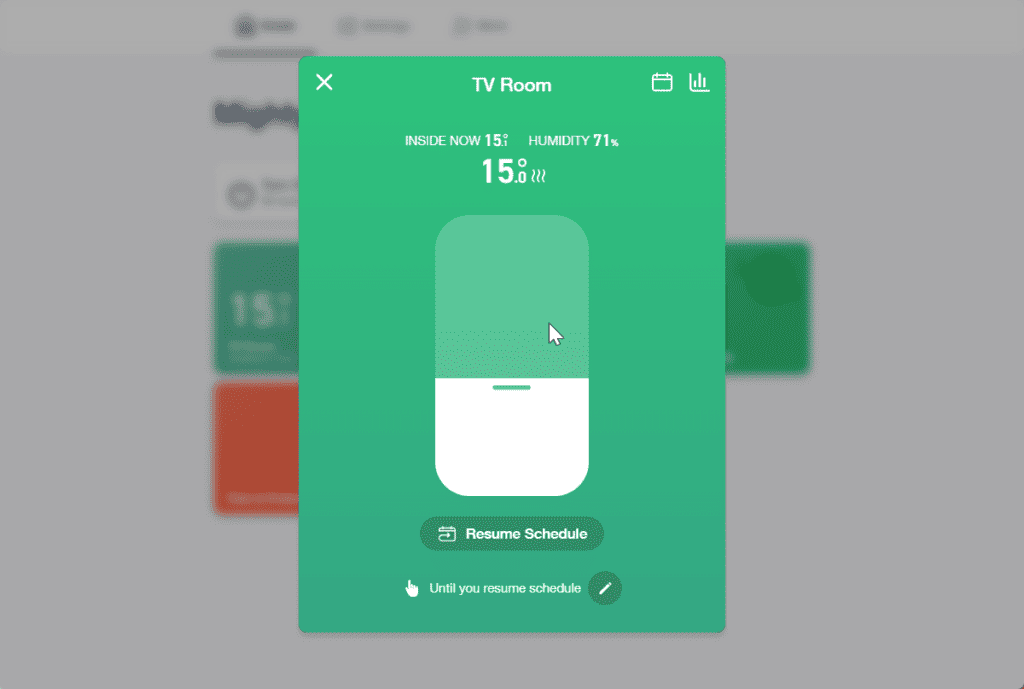
The companion app is user-friendly with a clean, intuitive interface. It allows for easy scheduling manual overrides and also provides insightful reports on your heating patterns and energy savings.
You can also manage your system through a browser, which is a feature I like as I spend all day working on my PC and find managing things easier on a big screen.
One concern is the lack of 2FA for additional security. You can see which phones the person is using (if they have multiple devices), but you can’t see who is logged in via the web.
Performance
As I work from home and have quite an obsessive routine, I don’t particularly need fancy features, but normal people will likely appreciate them.
One useful feature under the scheduling is the option to have a home and away mode, making it easier to adjust your schedule based on occupancy.
If you have a subscription, this then works with the geofencing, allowing you to switch to away mode when no one is home automatically.
The scheduling system is very similar to what I was using with Genius Hub, and you can create as many time blocks as you want. You also can have schedules per day, or for the work week, then separate on Saturday/Sunday, or the same schedule all week.
With Aqara, the scheduling system is more convoluted because it works the same as the other Aqara devices, so you have to use the if this, then that method of automating devices. While you can assign devices to a room, it doesn’t allow for easy, full room control either, I have to adjust each valve. You can group things like lights but not the radiator valves.
Similar to Genius Hub, you can manually control the heating for the room. By default, it will heat to the select temperature until the next schedule change, but you can adjust it to any time you want.
For all the valves I have, you can view historic data for temperature. However, the Tado valves also show humidity.
As I have been using smart radiator valves for the past few years, I can’t confirm how much these save on heating. However, I am completely sold on the idea of smart TRVs, I live in a reasonably large 4-bed semi that is quite old and not very energy efficient. There are only two of us, and I work from home. So, in my scenario, it would be madness to heat the entire house when I use one room all day, and there is no way I would go around and manually dial down the TRVs for each room every morning/evening.
Subscription
One issue with Tado is that they have walled off some features in a subscription model. You don’t have to use it, though.
The subscription enables Auto-Assist, which allows you to use Open Window Detection and Geofencing to subtly adjust the temperature whether you’re letting the breeze in or if you’re out of the house.
With the free subscription, you still have geofencing and open window detection, but you just get a push notification.
You also get Energy IQ, and Care & Protect can also keep an eye on your bills and your boiler so you can spend more time on the more important things in life.
If those features appeal to you, it is thankfully not too expensive at £3.99 per month or £29.99 per year.
Price and Alternative Options
The Tado Smart Radiator Thermostat – Starter Kit V3+ has an RRP of £130, and the Smart Radiator Valves themselves cost £75. Tado is one of those companies where you should never need to pay the full RRP.
At the time of writing (30th October), the starter kit doesn’t appear to be cheaper elsewhere, but you can pick up the valves for just £49 on Amazon. Amazon has the starter kit with two valves, which at the £200 RRP at the time of writing but has been as low as £140 back in September.
The V3+ Basic valve has an RRP of £60 and has been as low as £40, but no discounts were available at the time of writing.
The Genius Hub valves for my existing system are £90.
The Aqara Smart Radiator Thermostat E1 is around £50 but has been as low as £40. There is no boiler control with Aqara.
TP-Link Kasa has recently launched the KE100 smart TRV, which is £35 for the valve, but they don’t have boiler control.
Overall
There isn’t much to criticise with the Tado smart radiator thermostat valve. They were easy to install, easy to set up, the controls are simple and intuitive, there is good third-party support with easy integration with Home Assistant, and the overall performance has been excellent.
I haven’t used the system long enough to gauge how well the battery life compares to my other smart radiator valves.
I personally didn’t think the noise of the valves was any worse/better than my existing valves, either.
I am not keen on the subscription model, but thankfully, the features this offers are not essential for my use, and it is quite cheap at £30 per year.
Overall, I the Tado smart radiator thermostat valves are superb, and I will hopefully slowly convert my entire system to Tado.
Summary
Overall, I the Tado smart radiator thermostat valves are superb, and I will hopefully slowly convert my entire system to Tado. They were easy to install, easy to set up, the controls are simple and intuitive, there is good third-party support with easy integration with Home Assistant, and the overall performance has been excellent.
Overall
85%-
Overall - 85%85%
Pros
- Easy to install and a user friendly app
- Relatively affordable, especially if you want a system for whole home heating
- Excellent third party integration
Cons
- Some features are walled off in a subscription
I am James, a UK-based tech enthusiast and the Editor and Owner of Mighty Gadget, which I’ve proudly run since 2007. Passionate about all things technology, my expertise spans from computers and networking to mobile, wearables, and smart home devices.
As a fitness fanatic who loves running and cycling, I also have a keen interest in fitness-related technology, and I take every opportunity to cover this niche on my blog. My diverse interests allow me to bring a unique perspective to tech blogging, merging lifestyle, fitness, and the latest tech trends.
In my academic pursuits, I earned a BSc in Information Systems Design from UCLAN, before advancing my learning with a Master’s Degree in Computing. This advanced study also included Cisco CCNA accreditation, further demonstrating my commitment to understanding and staying ahead of the technology curve.
I’m proud to share that Vuelio has consistently ranked Mighty Gadget as one of the top technology blogs in the UK. With my dedication to technology and drive to share my insights, I aim to continue providing my readers with engaging and informative content.
Last update on 2025-07-12 / Affiliate links / Images from Amazon Product Advertising API

